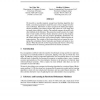Free Online Productivity Tools
i2Speak
i2Symbol
i2OCR
iTex2Img
iWeb2Print
iWeb2Shot
i2Type
iPdf2Split
iPdf2Merge
i2Bopomofo
i2Arabic
i2Style
i2Image
i2PDF
iLatex2Rtf
Sci2ools
117
Voted
NIPS
2000
2000
Rate-coded Restricted Boltzmann Machines for Face Recognition
We describe a neurally-inspired, unsupervised learning algorithm that builds a non-linear generative model for pairs of face images from the same individual. Individuals are then recognized by finding the highest relative probability pair among all pairs that consist of a test image and an image whose identity is known. Our method compares favorably with other methods in the literature. The generative model consists of a single layer of rate-coded, non-linear feature detectors and it has the property that, given a data vector, the true posterior probability distribution over the feature detector activities can be inferred rapidly without iteration or approximation. The weights of the feature detectors are learned by comparing the correlations of pixel intensities and feature activations in two phases: When the network is observing real data and when it is observing reconstructions of real data generated from the feature activations.
Related Content
| Added | 01 Nov 2010 |
| Updated | 01 Nov 2010 |
| Type | Conference |
| Year | 2000 |
| Where | NIPS |
| Authors | Yee Whye Teh, Geoffrey E. Hinton |
Comments (0)

